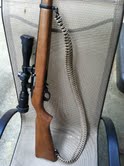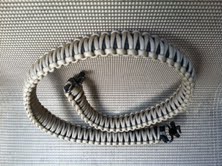by Todd Walker
One of our readers, winonageek, commented recently on my 550 Paracord Rifle Slings. “I love the idea for an adjustable paracord sling. Would you elaborate on how you made the adjustable sling? How did you connect the paracord and webbing?”
So, I thought I’d deconstruct it for him and anyone else interested.

After making my first paracord rifle sling, I attached it to a Ruger 10-22. Hum, nice fit, look, and functionality for redundant cordage. But what if I wanted to adjust the length for, say, a shotgun, or a longer rifle for a barrel-chested friend? My wheels were spinning. Off to Wally World to find a cheap clasp.
I dug into my box of webbing and found a piece of 1 inch material about two feet in length. More digging produced a buckle thingy (Triglide) used to connect the two loose ends of webbing.
I used about 80 feet of black paracord because, well, it’s the only color I had in a 100 foot hank that day.
Stuff you’ll need
- Paracord – about 80 feet – I use 100 feet ’cause I hate being too short at the climax of a project 🙂
- 1 inch x 28 inch webbing – more length depending on how many Twinkies you’ve packed away on your waistline
- Buckle thingy (Triglide)
- 2 sling swivels
- 1 buckle clasp – I used a 1 inch clasp to fit my webbing
Connecting the stuff
A.) Start one end of the paracord on one sling swivel and the other end through the female part of the clasp. I loop the cord through four times on both connectors. That’s unnecessary for strength, but just looks better than two loops on the connectors.
Do a basic cobra weave down the entire length starting at the clasp end. Once you reach the sling swivel, begin a king cobra weave (video link) on top of the previous cobra weave. I ran the king cobra weave about 20 inches and terminated the weave. The entire length of the paracord portion, from swivel to clasp, is about 24 inches. This measurement does not include the clasp and sling swivel.
Once you have the sling secured to the female clasp and sling swivel, it’s time to attach the webbing to the remaining hardware: sling swivel #2, buckle thingy (Triglide), and the male end of the clasp. To save you the trial-and-error method and a load of frustration, follow these procedures closely.
B.) I bent about 1/2 inch of webbing and melted it to itself to create a “stop” for the triglide. That step is probably not required. Then take the buckle thingy and feed the webbing through as shown.
C.) Now you can feed the clasp (male end) and sling swivel #2 on the webbing. Make sure they both are facing out like the buckle pictured below.
D.) Take the loose end of the webbing and feed it back through the buckle – on top of the end already in the buckle. Your done. Adjusting the length is done by sliding the loose end to fit. My sling is comfortable at around 38-39 inches end to end. Remember to use longer webbing for a longer sling.
That’s it. I’m sure there are better, more functional methods, but this is what I had on hand except for the clasp. I used Uncle Mike’s sling swivels that I already had in my gun cleaning box. I never throw away webbing. The buckle was poached from my paracord supply bag. My total cost was under $10.00. I know. If I had to buy all the supplies upfront, it would cost more. It pays to stock up and be a scavenger.

As always, if you have a better idea for making an adjustable paracord sling, don’t be shy. Please let me know how to improve this puppy.
Keep Doing the Stuff,
Todd
P.S. – You can also keep up with the Stuff we’re Doing on Twitter, Pinterest, Google +, and our Facebook page… and over at the Doing the Stuff Network on Pinterest, Google +, and Facebook.
P.P.S – If you find value in our blog, Dirt Road Girl and I would appreciate your vote on Top Prepper Sites! You can vote daily by clicking here or on the image below. Check out all the other value-adding sites while you’re there…
Thanks for Sharing the Stuff!
Copyright: Content on this site (unless the work of a third-party) may be shared freely in digital form, in part or whole, for non-commercial use with a link back to this site crediting the author. All links in articles must remain intact as originally posted in order to be republished. If you are interested a third-party article, please contact the author directly for republishing information.



















